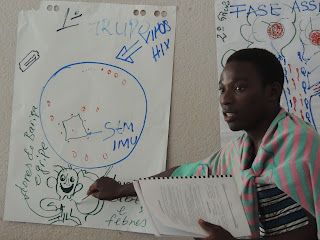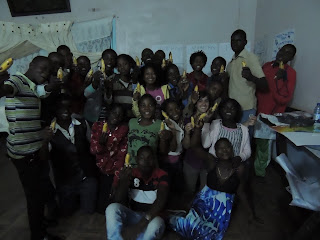They approached me on their own, a year ago. I had started
running alone, and then a couple of the other teachers came along, and then
after a few months, 10 teenage girls had joined us.
I love being with them because each of them has
something about her that reminds me of myself as a 15-year-old. And, being
with them reminds me that teenagers everywhere go through the same phases and
issues. They try to impress each other, don’t want to be left out or left
behind, some are leaders and some are followers, they all have different body shapes
and abilities, and they push each other to go further without consciously realizing
it.
The running group eventually morphed into a soccer team with me as the coach, which is a concept that would make you laugh out loud if you have ever seen me try to play soccer, but alas, none of you has seen this phenomenon, because, alas, I don't play soccer. How did I become a soccer coach if I don't play soccer? Re-read the story above.
Let's just say fighting The Gender Battle in Nauela is indeed a battle, because I don't think it has ever been fought here before. Of the three times I've gotten angry in the past two years, three of them have been on the field. That's right. Three times out of three. The girls have been verbally abused, kicked off the field, taunted, had the ball stolen, and been completely ignored (ie, a group of boys played a game on the whole field while the girls were playing on half the field - so the boys were literally running through the girls' game, and they put their goalkeeper in the soccer net we were using. There were two games going on, in the same space, at the same time).To make a year-long story into one sentence, girls apparently aren't supposed play soccer. But, here we are, having practices (almost) every Tuesday and Thursday. It's a significant accomplishment. And, look! There's my team below, dressed in a variety of things that are not skirts or dresses that they managed to find in their houses or borrow from their friends.

Since there are very few other girls' soccer teams around, we usually play against this menacing-looking team pictured below. But do not fret, we're a more legitimate team than they are, because they only practice in the week preceeding the games, and the only games that they've had have been the two games against my team. They just look scary because the girls have uniforms and are slightly bigger (according to Nauela, this is because these girls live in a school dorm, and eat rice and beans every day, and therefore, have strong bones).
We have played against them twice, and managed to tie each time.
Profeta tries to intimidate the other team from the goalpost.
Flora (in all black minus one white stripe) - by far the best, fastest, strongest, and almost smallest player on my team - runs after the ball.
We don't really know what we're doing soccer-wise, but I know they're exercising, having fun, and demanding women's rights (they don't consciously know they're doing this, either)!
They run so fast they're blurry. And, I haven't quite figured out how to use my camera yet.
That ball was white a few months ago. It means we're getting lots of use out of it. Thank you, Tiffany's class!!!

























